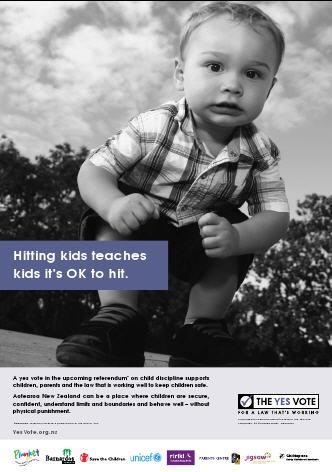Gordon Campbell: Why the citizens referendum in July is a futile way to spend $10 million
June 8, 2009

By now, the so called ’smacking’ debate is one of those issues that has been aired so thoroughly that its arrival back on the political agenda is like having an argumentative uncle turn up for Christmas dinner. He’s here again, there’s going to be a fight – and how long will it be before he goes away again ?
Next month, in the middle of a recession, New Zealand is set to spend something close to $10 million on a citizens initiated referendum (CIR) on the subject. The result will not be binding on the government and – judging by our previous track record on CIR that are NOT held at election time – the turnout can be expected to be low. The 1995 firefighters CIR attracted a turnout of only 28%.
This year’s referendum is being held nearly two years after the legislation that amended S59 of the Crimes Act – thus removing the defence of ‘reasonable force’ in cases involving parental violence against children – was passed by Parliament by a majority of 113 votes to 8. This year, in a classic case of putting the cart before the horse, the country will be holding its postal vote on the CIR before the Ministry of Social Development has finished its review of how the new legislation has been working. That review is not due to be released until September or October.
So far, the Act – and with it, the operational discretion available to Police on whether it is in the public interest to prosecute – appears to be working exactly as the law makers intended. Parents are not being criminalised en masse by the law change, as some had feared. In the one headline case where a Police prosecution was mounted, the jury agreed with the prosecution that the 50 year old parent involved had indeed committed an assault when he flicked his four year old child’s ear, pulled his hair and punched him in the face.
In July though, the public will not be asked to deliver a verdict on the law that was passed in 2007, or on how that the Police have administered it since. The referendum question is :“Should a smack as part of good parental correction be a criminal offence in New Zealand?” With the best will in the world, it is hard to see how any MP – or any citizen – who supported the verdict of Parliament could wholeheartedly answer either “Yes” or “No” to such a formulation, since it begs the question in at least two important respects.
One, It contains a value judgment about the context (“ good parental correction”) and secondly, it assumes the question of whether, under current Police procedures, such a smack can ever be a criminal offence. Essentially, the public is being asked to pass a judgement on a scenario that two years down the track, has not eventuated.
Still, that is the question that has been accepted by the Clerk of the House for the vote, and freedom of speech factors should carry a great deal of weight. After all, this is a procedure initiated by citizens, and official intrusion has to be kept to the absolute minimum. On the other hand, some $10 million of public money is likely to be spent on this process. For that reason alone, the procedures for CIR deserve closer scrutiny.

For answers, I consulted Dr John Parkinson of York University in the United Kingdom. Parkinson, a New Zealander, has written extensively on issues of direct democracy, With good reason in the past, Parkinson has criticised the high hurdle that any citizens initiated referendum in New Zealand has to meet before it can trigger a ballot. The organizers are given only one year ( plus a brief extension in extenuating circumstances) to collect supportive signatures from ten per cent of the voting population.
In this case, that meant Larry Baldock and the other organizers of the ‘anti-smacking’ CIR had to gather about 285,000 signatures – which boils down to a requirement to gather on average, 781 signatures each day, every day, for an entire year. No wonder very few CIR ever manage to make the signature target. When taken together with the high 5% threshold for MMP, it is another reason why politicians should never be trusted to write the checks (or cheques) and balances on how democracy should operate. Compare the New Zealand situation with Switzerland, which gives campaigners 18 months to gather 100,000 signatures – or just 1.75% of registered voters, at a rate of only 182 a day.
On the other hand, Baldock may care to rethink his previously stated enthusiasm for California’s citizens initiated measures. As I pointed out a year ago, the threshold for initiatives in California may be only 5% of voters registered for the previous elections for governor, but these must be gathered in only 150 days, at a rate of 2,492 a day – and while the result is binding, such statutes can be (and regularly are) struck down subsequently by the courts, on constitutional grounds.
First, I asked Parkinson this question : How do other countries manage, if at all, the issue of leading or loaded questions in CIR ? “The New Zealand CIR institution,” Parkinson replied, “ is unique, because there is no draft law being voted on. In those US states which use the device, CIR are not “questions” but complete laws or constitutional amendments. You have to have a legal team to draft a complete Bill, and that’s what gets sent to a vote. In Switzerland, initiatives take the form of constitutional amendments. Thus, Swiss and US voters have a lot more to go on than New Zealand voters do. The latter have just a vague statement of intent which Parliament (which is sovereign, remember, not ‘the people’) has to interpret, consider and respond to.”
Also, Parkinson adds, no one else in the world operates an ‘acceptability’ test for CIR questions. “In the US, any such requirement would breach the First Amendment. Instead, they leave it up to other groups to come up with competing propositions, and put all the competing ones on the same ballot. It’s a ferociously expensive process, which means only the very well-funded have any chance. In Switzerland, they handle it by means of (a) delaying tactics. The Federal Council can choose any time it likes to hold the vote – and (b) government counter-proposals which go to a vote at the same time as the citizen’s initiative. Counter-proposals almost always win. In other words, no-one tries to filter out bad ideas in advance. They trust to the competitive democratic process to reveal the flaws in proposals. Having options [counter-proposals] helps.”

Thirdly, he says, questions are vetted in New Zealand, once they have passed the signature target. The precise question has to be agreed between the Clerk of the House of Representatives and the proposer, so that it meets the requirements of the CIR Act 1993. “ The ‘leading question’ issue has not come up in the three previous CIR that went to a vote,” Parkinson says, “but one, the Withers referendum [on crime, held in 1999] clearly breached the requirements of the Act in that it asked at least four separate questions. Mr Withers was extraordinarily resistant to the Clerk telling him to simplify it, and my interpretation of the correspondence between them is that the Clerk thought there was no point continuing an unpleasant fight when the vote would not make a difference anyway. That is my interpretation, not the Clerk’s. I don’t know what the process was in this case.”
Should loaded questions be ruled out? Well, in defence of the organizers of this year’s referendum, it is certainly not unknown for even government–initiated referendums, much less CIRs, to ask value-loaded questions. John Howard’s Australian republic referendum in 1999 for instance, was not shy about assuming the outcome that it sought, and nor was Augusto Pinochet’s ‘defence of the dignity of Chile’ referendum in 1988. Only those who didn’t care about Chile’s dignity – or who were too gutless to defend it – could disagree with El General, and his modus operandi.
The second question posed to Parkinson was : Given the track record of low turnout in New Zealand on non-binding postal CIR held outside the context of an election, what sort of majority can fairly compel a government to pay heed – and does overseas practice on non-binding referenda give us any guidance?
In other words, if ten per cent of voters seek a CIR, and only 30 % of the public respond, and 80% of those that respond express the same opinion, what weight – if any – should be given to that result by the government ?
There are three camps on the “what weight” question, Parkinson replies. “One, ‘pure majoritarianism’ says that 50%+1 is the only justifiable decision rule, and turnout has nothing to do with it. The second “consensus” camp says that there’s no hard and fast rule, but the higher the winning margin and the higher the turnout, the more legitimate the outcome.
The third is a “super-majority rule” which says you need 50%+1 of total votes, plus a majority in most or all states, or among ethnic groups, or religions, or whatever the major cleavage in society is. The point of super-majorities is to ensure that small states or groups don’t get steamrollered by the big ones all the time.” The examples, he says, include:
– Australian constitutional referendums that require an overall majority of voters, plus a majority in EVERY state;
– Swiss CIR that require an overall majority of the vote, plus a majority in more than half the cantons.

Other examples ? “There are two kinds of turnout restriction,” Parkinson concludes. “In Italy, so called “abrogative referendums”, allow citizens to challenge laws, but they require a turnout of 50%+1.” Otherwise, compulsion can always settle the question of turnout. Australia, Belgium, Brazil, and 27 other countries have compulsory voting, and that effectively settles any legitimacy question about the turnout.
Overall, Parkinson comes down on the side of the obvious. “ My view is that, given the non-binding nature of the vote, a big majority on a low turnout is not as compelling as a big majority on a big turnout. If it’s binding, then I like the double-majority system – it forces people to try to persuade each other rather than just bully each other. The decision rule should still be 50%+1 though. I don’t have a considered view on the turnout requirement, but my gut reaction is to prefer compulsory voting – it becomes a badge of citizenship, and not a burden.”
Plainly, compulsory voting – especially on some lobby group’s pet CIR topic – is not a runner in New Zealand, Perhaps it should be, when a highly organized 10 % of the population can compel the wider public to spend $10 million on a process that Parliament, in its considered wisdom, is then free to ignore.
At the very least, the Key government will be wanting to wait and hear from the MSD review of the current law – and how it is operating – before reaching any decision. Unfortunately, the public will not be able to do likewise
by Gordon Campbell at Werewolf
Republished with permission











